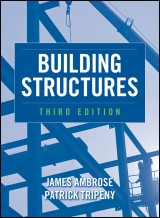Details

Building Structures
3. Aufl.
|
132,99 € |
|
| Verlag: | Wiley |
| Format: | |
| Veröffentl.: | 13.09.2011 |
| ISBN/EAN: | 9781118067000 |
| Sprache: | englisch |
| Anzahl Seiten: | 544 |
DRM-geschütztes eBook, Sie benötigen z.B. Adobe Digital Editions und eine Adobe ID zum Lesen.
Beschreibungen
The comprehensive reference on the basics of structural analysis and design, now updated with the latest considerations of building technology <p>Structural design is an essential element of the building process, yet one of the most difficult to learn. While structural engineers do the detailed consulting work for a building project, architects need to know enough structural theory and analysis to design a building. Most texts on structures for architects focus narrowly on the mathematical analysis of isolated structural components, yet Building Structures looks at the general concepts with selected computations to understand the role of the structure as a building subsystem—without the complicated mathematics.</p> <p>New to this edition is a complete discussion of the LRFD method of design, supplemented by the ASD method, in addition to:</p> <ul> <li> <p>The fundamentals of structural analysis and design for architects</p> </li> <li> <p>A glossary, exercise problems, and a companion website and instructor's manual</p> </li> <li> <p>Material ideally suited for preparing for the ARE exam</p> </li> </ul> <p>Profusely illustrated throughout with drawings and photographs, and including new case studies, Building Structures, Third Edition is perfect for nonengineers to understand and visualize structural design.</p>
<b>Preface ix</b> <p><b>Introduction xi</b></p> <p><b>1. Basic Concepts 1</b></p> <p>1.1 Basic Concerns 1</p> <p>1.2 Architectural Considerations 3</p> <p>1.3 Structural Functions 12</p> <p>1.4 Structural Materials 18</p> <p>1.5 Structural Systems 21</p> <p><b>2. Investigation of Structures 39</b></p> <p>2.1 Introduction to Structural Investigation 39</p> <p>2.2 Static Forces 41</p> <p>2.3 Stresses and Strains 56</p> <p>2.4 Special Topics 63</p> <p>2.5 Dynamic Behavior 75</p> <p><b>3. Structural Elements 80</b></p> <p>3.1 Beams 80</p> <p>3.2 Tension Elements 88</p> <p>3.3 Compression Elements 93</p> <p>3.4 Trusses 99</p> <p>3.5 Rigid Frames 104</p> <p>3.6 Special Structures 112</p> <p><b>4. Wood Structures 114</b></p> <p>4.1 General Concerns forWood 114</p> <p>4.2 Wood Products and Systems 117</p> <p>4.3 Design Data for Structural Lumber 124</p> <p>4.4 Wood-Spanning Systems 126</p> <p>4.5 Wood Trusses 134</p> <p>4.6 Wood Columns 139</p> <p>4.7 Fasteners and Connections forWood 147</p> <p><b>5. Steel Structures 153</b></p> <p>5.1 General Concerns for Steel 153</p> <p>5.2 Steel Beams, Joists, and Decks 158</p> <p>5.3 Steel Columns 187</p> <p>5.4 Bolted Connections for Steel Structures 196</p> <p>5.5 Steel Trusses 202</p> <p><b>6. Concrete Structures 203</b></p> <p>6.1 General Concerns for Concrete 203</p> <p>6.2 Reinforced Concrete Flexural Members 211</p> <p>6.3 Concrete Columns 238</p> <p>6.4 Concrete Foundations 247</p> <p><b>7. Masonry Structures 259</b></p> <p>7.1 General Concerns for Masonry 259</p> <p>7.2 StructuralMasonry 262</p> <p>7.3 Masonry with Concrete Units 267</p> <p>7.4 Form and Classification of Compression Elements 270</p> <p>7.5 Brick Masonry 271</p> <p>7.6 Miscellaneous Masonry Construction 276</p> <p>7.7 Adobe Construction 279</p> <p>7.8 Hollow Clay Tile 279</p> <p><b>8. Building Foundations and Site Structures 281</b></p> <p>8.1 General Considerations 281</p> <p>8.2 Soil Properties and Foundation Behavior 283</p> <p>8.3 Shallow Bearing Foundations 293</p> <p>8.4 Elements of Foundation Systems 298</p> <p>8.5 Deep Foundations 304</p> <p>8.6 Special Problems and Construction 308</p> <p><b>9. Lateral-Force Effects 316</b></p> <p>9.1 General Considerations for Lateral Effects 316</p> <p>9.2 Wind Effects on Buildings 335</p> <p>9.3 Earthquake Effects on Buildings 341</p> <p>9.4 Elements of Lateral Resistive Systems 350</p> <p><b>10. Building Structures Design Examples 381</b></p> <p>10.1 General Concerns for Structural Design 381</p> <p>10.2 Building One 392</p> <p>10.3 Building Two 399</p> <p>10.4 Building Three 410</p> <p>10.5 Building Four 414</p> <p>10.6 Building Five 416</p> <p>10.7 Building Six 418</p> <p>10.8 Building Seven 430</p> <p>10.9 Building Eight 455</p> <p>10.10 Building Nine 458</p> <p><b>Appendix A: Properties of Sections 468</b></p> <p><b>Appendix B: Glossary 483</b></p> <p><b>Appendix C: Exercise Problems 489</b></p> <p><b>Appendix D: Study Aids 504</b></p> <p><b>References 519</b></p> <p><b>Index 521</b></p>
<b>James Ambrose</b> is Editor of the Parker/Ambrose Series of Simplified Design Guides. He practiced as an architect in California and Illinois and as a structural engineer in Illinois. He was a professor of architecture at the University of Southern California. <p><b>Patrick Tripeny</b> is an Associate Professor, former director of the School of Architecture, and the current Director of the Center for Teaching and Learning Excellence at the University of Utah. He is a licensed architect in California. He has been the recipient of a number of teaching awards at the local and national level for his work in teaching structures and design. With James Ambrose, he is the coauthor of <i>Simplified Engineering for Architects and Builders, Eleventh Edition; Simplified Design of Steel Structures, Eighth Edition; Simplified Design of Concrete Structures, Eighth Edition</i>; and <i>Simplified Design of Wood Structures, Sixth Edition</i>, all published by Wiley.</p>
The comprehensive reference on the basics of structural analysis and design, now updated with the latest considerations of building technology <p>Structural design is an essential element of the building process, yet one of the most difficult to learn. While structural engineers do the detailed consulting work for a building project, architects need to know enough structural theory and analysis to design a building. Most texts on structures for architects focus narrowly on the mathematical analysis of isolated structural components, yet Building Structures looks at the general concepts with selected computations to understand the role of the structure as a building subsystem—without the complicated mathematics.</p> <p>New to this edition is a complete discussion of the LRFD method of design, supplemented by the ASD method, in addition to:</p> <ul> <li> <p>The fundamentals of structural analysis and design for architects</p> </li> <li> <p>A glossary, exercise problems, and a companion website and instructor's manual</p> </li> <li> <p>Material ideally suited for preparing for the ARE exam</p> </li> </ul> <p>Profusely illustrated throughout with drawings and photographs, and including new case studies, Building Structures, Third Edition is perfect for nonengineers to understand and visualize structural design.</p>

















